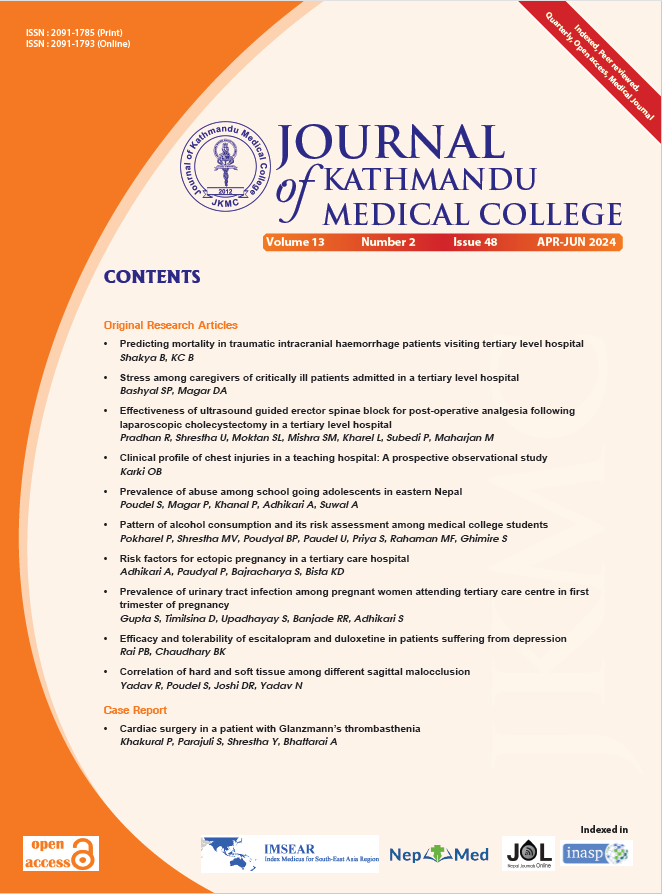Abstract
Introduction: Traumatic intracranial haemorrhage is a major contributor to trauma-related morbidity and mortality.
Existing prognostic models often lack accuracy, generalizability, and ease of application due to the complexity of required variables.
Objective: This study aimed to develop a simple yet accurate risk stratification model for predicting mortality in patients
with traumatic intracranial haemorrhage.
Methodology: A prospective study was conducted at the Department of Neurological Surgery, KMCTH, from January first to December 31st, 2020. A total of 200 patients with traumatic intracranial haemorrhage who underwent neurosurgical intervention were included, while those with infections, open wounds, or multiple planned surgeries were excluded. Data collected included age, sex, blood pressure, Glasgow Coma Scale, Injury Severity Score, type of intracranial haemorrhage, and body mass index. Mortality outcomes were assessed within 30 days. Statistical analyses, including univariate and multivariate logistic regression, were conducted using IBM SPSS Statistics for Windows version 16 ( Chicago, SPSS Inc.)
Result: The overall mortality rate was 35%. Independent predictors of mortality included age (OR: 1.05, 95% CI: 1.02
– 1.08), GCS score (OR: 0.85, 95% CI: 0.75 – 0.94), and ISS (OR: 1.12, 95% CI: 1.04 – 1.20). Cases with Subdural hematoma
had the highest mortality (60%) and decompressive craniectomy was associated with the highest mortality (45%) . The
proposed model demonstrated excellent discriminative ability (AUC = 0.89).
Conclusion: This study presents a reliable risk stratification model for predicting mortality in traumatic intracranial
haemorrhage patients, emphasizing key clinical variables. These findings may improve decision-making, facilitate timely
interventions, and optimize trauma care resources.
References
Maas AI, Stocchetti N, Bullock R. Moderate and severe traumatic brain injury in adults. Lancet Neurol. 2008;7(8):728-741. [PubMed | Full Text | DOI]
Roozenbeek B, Maas AI, Menon DK. Changing patterns in the epidemiology of traumatic brain injury. Nat Rev Neurol. 2013;9(4):231-236. [PubMed | Full Text | DOI]
Perel P, Edwards P, Wentz R, Roberts I. Systematic review of prognostic models in traumatic brain injury. BMC Med Inform Decis Mak. 2006;6:38. [PubMed | Full Text | DOI]
Steyerberg EW, Mushkudiani N, Perel P, et al. Predicting outcome after traumatic brain injury: development and international validation of prognostic scores based on admission characteristics. PLoS Med. 2008;5(8):e165. [PubMed |
Full Text | DOI]
Faul M, Xu L, Wald MM, Coronado VG. Traumatic brain injury in the United States: emergency department visits, hospitalizations, and deaths 2002–2006. Atlanta (GA): Centers for Disease Control and Prevention, National Center for Injury Prevention and Control; 2010. [Full Text]
. Tagliaferri F, Compagnone C, Korsic M, Servadei F, Kraus J. A systematic review of brain injury epidemiology in Europe. Acta Neurochir (Wien). 2006;148(3):255-268. [PubMed | Full Text | DOI]
. Marmarou A, Lu J, Butcher I, et al. Prognostic value of the Glasgow Coma Scale and pupil reactivity in traumatic brain injury assessed pre-hospital and on enrollment: an IMPACT analysis. J Neurotrauma. 2007;24(2):270-280. [PubMed | Full Text | DOI]
Perel P, Edwards P, Wentz R, Roberts I. Systematic review of prognostic models in traumatic brain injury. BMC Med Inform Decis Mak. 2006;6:38. [PubMed | Full Text | DOI]
Steyerberg EW, Mushkudiani N, Perel P, et al. Predicting outcome after traumatic brain injury: development and international validation of prognostic scores based on admission characteristics. PLoS Med. 2008;5(8):e165. [PubMed |
Full Text | DOI]
Roozenbeek B, Maas AI, Menon DK. Changing patterns in the epidemiology of traumatic brain injury. Nat Rev Neurol.2013;9(4):231-236. [PubMed | Full Text | DOI]
Teasdale GM, Jennett B. Assessment of coma and impaired consciousness. A practical scale. Lancet. 1974;2(7872):81-84. [PubMed | Full Text | DOI]
Gerber LM, Chiu YL, Carney N, et al. Marked reduction in mortality in patients with severe traumatic brain injury. J Neurosurg. 2013;119(6):1583-1590. [PubMed | Full Text | DOI]
Reilly P. The impact of neurotrauma on society: an international perspective. Prog Brain Res. 2007;161:3-9. [PubMed | Full Text | DOI]
MRC CRASH Trial Collaborators, Perel P, Arango M, et al. Predicting outcome after traumatic brain injury: practical prognostic models based on large cohort of international patients. BMJ. 2008;336(7641):425-429. [PubMed | Full Text | DOI]
Collaborators MCT, Perel P, Arango M, et al. Predicting outcome after traumatic brain injury: practical prognostic models based on large cohort of international patients. BMJ. 2008;336(7641):425-429. [PubMed | Full Text | DOI]
Kakarieka A, Csomor D, Klein B, Rizoli S, Tien H, Nathens A, et al. Predictors of outcomes in traumatic brain injury: Results from a single-center retrospective cohort. World Neurosurg. 2016;88:525–533. [PubMed | Full Text | DOI]
Draper K, Ponsford J. Cognitive functioning ten years following traumatic brain injury and rehabilitation. Neuropsychology. 2008;22(5):618–625. [Full Text | DOI]
Stocchetti N, Carbonara M, Citerio G, Ercole A, Skrifvars MB, Smielewski P, et al. Severe traumatic brain injury: targeted management in the intensive care unit. Lancet Neurol. 2017;16(6):452-464. [Full Text ]
Hutchinson PJ, Kolias AG, Timofeev IS, et al. Trial of Decompressive Craniectomy for Traumatic Intracranial Hypertension. N Engl J Med. 2016;375(12):1119-1130. [PubMed | Full Text | DOI]
Sahuquillo J, Dennis JA. Decompressive craniectomy for the treatment of high intracranial pressure in
closed traumatic brain injury. Cochrane Database Syst Rev. 2019;2019(12):CD003983. [PubMed | Full Text | DOI]
Malec JF, Brown AW, Leibson CL, Flaada JT, Mandrekar JN, Diehl NN, Perkins PK. The Mayo Classification
System for Traumatic Brain Injury Severity. J Neurotrauma. 2007 Sep;24(9):1417–1424. [PubMed | Full Text | DOI]
Vieira RCA, Silveira JCP, Paiva WS, de Oliveira DV, de Souza CPE, Santana-Santos E, de Sousa RMC. Prognostic models in severe traumatic brain injury: a systematic review and meta-analysis. Neurocrit Care. 2022;37(3):790–805. [PubMed | Full Text | DOI]

